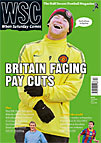 Mark Rowe explains why fewer stewards and a loosening of health and safety regulation may see standards at stadiums decline
Mark Rowe explains why fewer stewards and a loosening of health and safety regulation may see standards at stadiums decline
John Rutherford was insistent. If a group of home fans wanted to bring their giant flag in, they had to show a fire safety certificate. It was April 2009 and Rutherford, the formidable safety officer at Sheffield Wednesday, had a lot on his plate. As well as the usual matchday duties there were TV crews doing live interviews for the 20th anniversary of Hillsborough.
My team, Derby County, were the visitors and because of Derby’s intense rivalry with Nottingham Forest – the team facing Liverpool that day in 1989 – Wednesday contentiously decided against a ceremony to mark the anniversary beforehand, in case Rams fans spoiled it. My first thought about the flag was that it represented “health and safety gone mad”. But what if the flag wasn’t fire-safe? As fans rolled it over their heads, you would only need one idiot with a cigarette lighter and hundreds of people would have flames above their heads. That’s why we have health and safety.
Although we will not have the Football Licensing Authority – the body that arose from the Taylor Report, itself a response to the Hillsborough disaster – for much longer. As part of the coalition government’s scrapping of quangos, in 2012 the FLA will become part of the Health and Safety Executive. A handful of MPs signed an early day motion deploring this. In truth, the FLA’s work in issuing licences for football grounds will carry on.
Keeping a licence depends on everything from Premier League and Championship stadiums being all-seater (and Leagues One and Two having standing areas “of the prescribed standard”) to training stewards and looking after disabled fans. All worthy and boring, but the UK can now claim to be a world leader in stadium safety. That’s one of the reasons that we’re hosting London 2012 and bidding for the 2018 World Cup, and why in October Sepp Blatter could contrast the UK’s safe unfenced stadia with the recent violence at Italy v Serbia in Genoa. “Where are the hooligans?” the FIFA president rhetorically asked David Cameron at 10 Downing Street. Cameron’s policies, however, may be jeopardising the country’s hard-won safety record.
Like other public bodies the FLA is not replacing staff, such as inspectors, when they retire. Separately, the coalition is championing “lighter touch” regulation of health and safety in general. The Tory spin is that health and safety is too often an unnecessary burden on business. And as you click through the turnstile and take your plastic seat – checked before and after the game by stewards doing a “walk through” – you may agree with the government. Stadiums are much improved, far safer than a Saturday night in town. We’ll never go back to the bad old 1980s of cages and riot-ready police.
However, health and safety comes at a cost. The businessmen running stadiums (or anywhere else) will be tempted to skimp: fewer stewards here; leaving a CCTV camera broken there, and rather than repair that broken toilet or step, put tape around it. This new climate – that health and safety gets in the way – will make it harder for the safety managers on the front line. Regular fans may not notice a thing initially. Hooligans might find their life easier, though, especially if police have to cut back on the supply of intelligence officers that have reached as far down the pyramid as the Blue Square North and South.
The gains in spectator safety and comfort, so painfully won, could be chipped away, in tiny, seldom visible ways you cannot easily fight. The first you may know about it is when you’ve had a bit to drink and you trip over a broken step. Or a bunch of drunks get out of hand and no one official steps in to stop it. You’ll never go on a protest march about this, but it’s something to think of the next time a giant flag passes over your head.
From WSC 286 December 2010